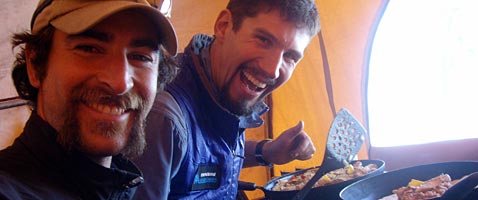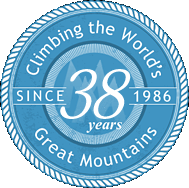
Food Suggestions for Mt. Rainier and Other Climbs
Whether you're climbing Mt Everest or Mt Rainier, climbing burns many calories, more than you're used to in your typical lifestyle routine. Being well fed is paramount to success on any mountain. IMG will provide you with breakfasts and dinners, using a menu designed to leave you feeling nourished and fueled for the climb ahead. Dinners may include: burritos, pesto pasta with salmon, or pad thai. Breakfasts may include: bagels with bacon, pancakes, or hashbrowns. Hot drinks will also be provided, including coffee, hot chocolate, cider, tea, and cup of soup. NOTE: menu items are easily adjusted to accommodate all dietary restrictions. Please notify your guide of any dietary needs upon your arrival.
You are responsible for providing your own lunches and snack food during your program. There isn't a designated lunch time each day, so you should anticipate snacking throughout the day. Plan to bring 7-8 snacks per day, 100-200 calories each. Options are endless but a few tried and true guide favorites are below:
- Cheese, salami and crackers
- Bagels with various toppings (dense calories and easy to pack)
- Tortilla wraps with lunchmeat and cheese
- Hardboiled eggs
- Leftover pizza
- Various bars of your preference
- Various nuts and dried fruit mixes (Trader Joe's has great options)
- Candy bars. Treat yourself to what you love.
- Soft chewy candies (Swedish fish)
- Precooked meats (Bacon, ham, etc.)
- Pretzel sticks and hummus
- Pringles
- Chocolate covered pretzels
- Crackers and cream cheese (double use on the cream cheese with the bagels)
When packing food for your upcoming climb, it's important to consider a few other variables: weight, durability, calorie density, enjoyment, etc.
Below are a few tips to consider along with some meal suggestions:
- Variety is key.
- Things get beat up in a backpack so consider durability (think bagels vs. bread).
- Bring foods you know and like.
- Bring a mix of sweet and savory.
- Remember extra food is far better than not enough.
- Precooked meats and cheeses can keep well given the temperatures and access to snow on this program.
- Bring some fresh food for the first day; fruits such as apples are calorie dense and delicious on a hot day.
- Some foods come in a convenient box/bag/can. Others need to be repacked in a Ziploc to maximize efficiency and rationing while avoiding taking unnecessary garbage into the field.
Food is important. Put some thought into your meals and snacks making them as concise and compact as possible.
Suggestions from IMG's Mt. Rainier Guides
Below are a few food recommendations from IMG guides who have spent a lot of time snacking on Mt. Rainier.
IMG Guide Peter Dale

A few factors I think about when packing food for a climbing trip are the calorie/weight ratio, packability/crushability, and amount that I actually enjoy eating any particular item. If you don't like carrot sticks at home, you certainly won't like them at altitude, so go ahead and binge on all that candy and chocolate you crave. Additionally, I think it is important to consider the macronutrient composition of the foods you're planning on bringing. Don't bring just nuts and beef jerky, you won't get enough simple carbohydrates to keep your body going. By the same token, don't bring just gummy candies, as you will surely "bonk" at some point. However, a combination of those snacks will provide a nice balance of protein, fats and carbohydrates. Lastly, don't get too hung up on how "healthy" a snack food is. While on a weekend trip you don't need to pack a bunch of semi-obscure vitamins and minerals into your diet. Any micronutrient imbalances you may have surely aren't going to be solved on a three day Rainier climb with granola bars.
A few of my favorite items:
- A piece of fresh fruit for one of the first snack breaks on day one (doesn't follow the weight rule, but sure is good on a hot day).
- Bagels with topping of your choice (great calories and packability).
- Cheese (goes well on many things, and very calorie dense).
- Salami (great calories, salt, fat and doesn't go bad as easily as deli meat)
IMG Guide Emily Johnston

One of the nice things about mountaineering is that it's a great reason to eat... a lot!
You can and should eat every time we stop for a break. On a typical 3 day climb of Mt. Rainier, I recommend bringing about sixteen 200-400 calorie snacks (that gives you a little extra).
For the first day, I bring a big deli sandwich with chips, a few Mojo bars, and some veggies.
Other great mountain food includes fun sized Snickers bars (small enough that you can put them in your mouth to thaw if they're frozen), dried mangos, nuts, chocolate covered almonds, M&Ms, Luna Bars, cheese and pita bread, good ol' PB&J... whatever your heart desires. If it doesn't appeal to you at home, it's not going to look good at 14,000 feet! The key is to bring food that's durable and palatable, that you can eat when it's frozen solid. Up high, I like Clif Shot Blocks (at least one pack with caffeine), Hot Tamales, and those fake candy orange slices. You can just stuff them in your pocket and munch on them as you're climbing.
This is a climb, not a diet opportunity, so save the sawdust bars for another time and treat yourself to whatever your "forbidden fruit" may be!
IMG Guide Austin Shannon

There are so many things to think about when planning for a trip. What boots to buy, what pack to wear... How many soft shell jackets do I really need? But one of the most important things you pack is what you put into your body during a climb and has a large impact on the physical performance during the climb. Here are a few items I like to eat that help power me up the mountain.
- Sweedish Fish. Fat Free! Good carbs and quick energy for those high altitude summits when nothing else sounds good.
- A nice cracker, meat, and cheese combo. No matter how much space food the guy at the gear store told you to buy, you still need sustenance and protein to power you in the long run. Find a nice mellow cheese, some good crackers, and a cured meat that will last a week in the backpack.
- Snickers goes a long way. Food stress is real. I have also seen many people bring way too much food. It's important to find the balance. If you're one to stress about food throw in an extra Snickers bar. Put it in the lid of your pack, or in a jacket for those emergencies.
Anytime you're shopping for food try and find a balance between sweet and salty. Think about bringing no more than a pound per day. Bring food you like to eat. If you don't like it down low, you certainly won't want to eat it up high. Pair the food down as much as possible. All those extra candy wrappers add up. And when in doubt, ask the guide.
IMG Guide Erica Engle

Things I take with me might include gooey cookies, a little bit of fresh fruit, like apple or peaches, chocolate or yogurt covered nuts, a few pieces of fried chicken, a package of cream cheese with salty crackers, jerky, some slices of moist banana or zuchini bread, a few bars that actually are tasty, some gummy candy, cheese of course with a yummy bread to go with it.
IMG Guide Eric Remza

Here are some ideas for those with the Gluten and wheat free diet... if you have access to a Trader Joe's, you can ask for a list of all the gluten and wheat free items/brands in the store.
- 70-80% dark chocolate, antioxidants, this candy is actually good for you.
- Columbus brand salami's. Most processed meats have gluten added to them.
- Sunflower seeds. With gluten and wheat free diets, you get hungry and need to eat every 2 hours — having a large bag of sunflower seeds is a great way to keep the hunger pains down...
- Jelly Belly jelly beans, gluten free candies; most candy have wheat or gluten added to them.
- Blue diamond almond crackers — the best wheat free cracker I have yet to find that is durable in the hills.

